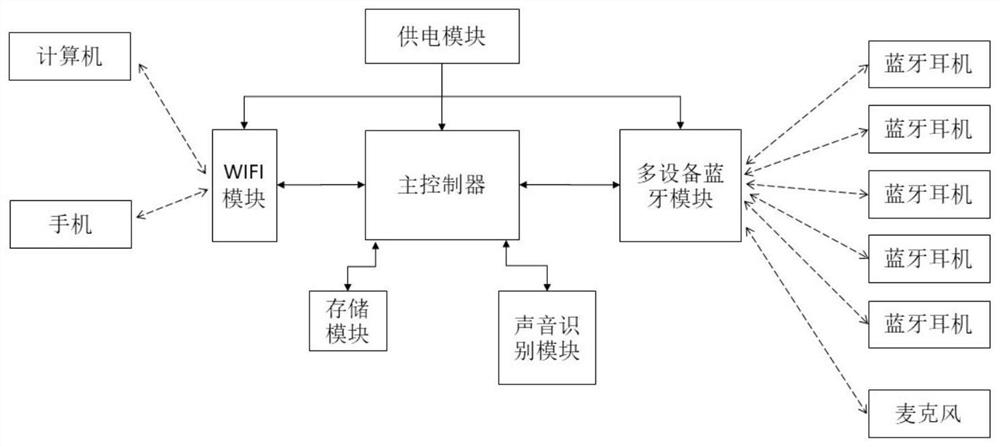Classroom sound interaction system
A voice interaction, classroom technology, applied in speech analysis, short-range communication services, security devices, etc., can solve other classroom interference, cheating, poor targeting, etc., to improve clarity, avoid differences, and reduce noise. good effect
- Summary
- Abstract
- Description
- Claims
- Application Information
AI Technical Summary
Problems solved by technology
Method used
Image
Examples
Embodiment 1
[0039] combine Figure 1-4 , a classroom sound interaction system, comprising a relay host 1, a computer 2, a mobile phone 3, a microphone 4, and a bluetooth headset 5; the relay host 1 can be wirelessly connected to a plurality of bluetooth headsets 5, and each bluetooth headset 5 has a unique identification information; the computer 2 and the mobile phone 3 can be wirelessly connected to the relay host 1, and the computer 2 or the mobile phone 3 can obtain from the relay host 1 the quantity and identification information of the bluetooth earphones 5 connected with the relay host 1;
[0040] The microphone 4 is wirelessly connected to the relay host 1, the sound signal recorded by the microphone 4 can be forwarded to the Bluetooth headset 5 by the relay host 1 in real time, the Bluetooth headset 5 has a radio function, and the sound signal collected by the Bluetooth headset 5 can be sent to the relay host 1 Perform character recognition and voiceprint recognition.
[0041] T...
Embodiment 2
[0052] This embodiment introduces the noise reduction process.
[0053] The main controller processes the sound signal obtained from the microphone 4 through noise reduction processing as follows:
[0054] The microphone 4 collects the first sound signal, and converts the first sound signal into the first digital sound signal, and then sends the first digital sound signal to the master controller of the relay host 1; a second sound signal, and convert the second sound signal into a second digital sound signal, and then send the second digital sound signal to the main controller of the relay host 1, and the main controller carries out multiple second digital sound signals. The signals are superimposed, and the volume is normalized to obtain a standardized second digital sound signal; the main controller performs fast Fourier transform on the first digital sound signal and the standardized second digital sound signal, and converts them into the first frequency domain signal and ...
Embodiment 3
[0056] This embodiment introduces the sign-in function, and the specific working method of the sign-in function is as follows:
[0057] Send a sign-in start signal to the relay host 1 through the computer 2 or the mobile phone 3, and the relay host 1 enters the sign-in mode;
[0058] By computer 2 or mobile phone 3, input accompanying text password to relay host 1, described accompanying text password is the text password that the user imports according to one's own preferences; Relay host 1 puts accompanying text password into storage module storage;
[0059] The Bluetooth headset 5 establishes a Bluetooth connection with the relay host 1, and the relay host 1 obtains identification information from the Bluetooth headset 5;
[0060] The sound recognition module obtains the sound signal uploaded by a bluetooth headset 5 from the main controller and performs character recognition and voiceprint recognition on the sound signal, and combines the results of character recognition a...
PUM
 Login to View More
Login to View More Abstract
Description
Claims
Application Information
 Login to View More
Login to View More - R&D
- Intellectual Property
- Life Sciences
- Materials
- Tech Scout
- Unparalleled Data Quality
- Higher Quality Content
- 60% Fewer Hallucinations
Browse by: Latest US Patents, China's latest patents, Technical Efficacy Thesaurus, Application Domain, Technology Topic, Popular Technical Reports.
© 2025 PatSnap. All rights reserved.Legal|Privacy policy|Modern Slavery Act Transparency Statement|Sitemap|About US| Contact US: help@patsnap.com



